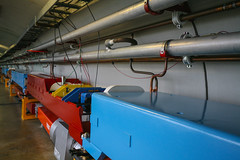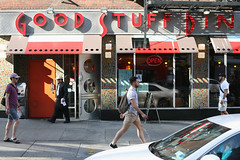Trevis Rothwell's weblog
7 February 2018
Over the recent holiday season, I read Dianne Ashton’s Hanukkah in America, which chronicles the history and development of Hanukkah (mainly in the United States) from its origins over 2000 years ago up through nearly present day.
For most of that time, Hanukkah was a fairly minor holiday on the Jewish calendar, perhaps not celebrated at all. Two catalysts worked together to encourage Jewish immigrants in the United States to make a bigger deal out of Hanukkah than their European ancestors had: their desire to retain and promote their own religious and cultural values; and Christmas.
Christmas also had not always been the major gift-giving, family-oriented holiday that we know today, but through the 1800s into the early 1900s it grew, for various reasons, including corporations turning it into a commercial event (as Charlie Brown might be all too familiar with!), and for the benefit of U.S. soldiers, either being sent Christmas care packages when abroad, or having more substantial family events when home.
As the appeal of Christmas events grew, and especially as the wonder of Christmastime grew in the eyes of children, Jewish children longed for something similar. They found what Christian families enjoyed in midst of winter to be enticing.
Many Jewish holidays have strict guidelines regarding what to do; if the holiday is traditionally observed, there is little or no room to modify how it is celebrated. Not so with Hanukkah, which was hardly celebrated at all. Thus there was room for Jews in the U.S. to adapt Hanukkah to meet their present-day needs, including more appeal to children.
Besides the appeal of Christmas, many Jewish people were feeling distant from their religious and social traditions, and their overall Jewish identity began to wane in the new homeland. This ended up being another opportunity for Hanukkah to grow, not only for children, but as a holiday for Jews of all ages to reflect on who they were as a people, and to strengthen family bonds.
A delightful read! Also available in electronic form.
17 January 2018
 Upgrading to a new Apple computer (2017 27-inch iMac) involved facing the fact that FireWire is truly ancient technology. I had already been linking my FireWire 400 Focusrite Saffire interface into my 2010 Mac Book Pro using a FireWire 400 -> FireWire 800 cable. Now to plug into a Thunderbolt 3 / USB-C port on the iMac, I am routing from FireWire 400 to FireWire 800 to Thunderbolt 2 to Thunderbolt 3… Amazingly, it works! But it does leave me contemplating an audio interface upgrade.
Upgrading to a new Apple computer (2017 27-inch iMac) involved facing the fact that FireWire is truly ancient technology. I had already been linking my FireWire 400 Focusrite Saffire interface into my 2010 Mac Book Pro using a FireWire 400 -> FireWire 800 cable. Now to plug into a Thunderbolt 3 / USB-C port on the iMac, I am routing from FireWire 400 to FireWire 800 to Thunderbolt 2 to Thunderbolt 3… Amazingly, it works! But it does leave me contemplating an audio interface upgrade.
Thus I was interested in a recent product announcement from Focusrite, a new Clarett audio interface that was touted as working with USB-C. This would plug directly into the iMac with no adapters, and USB-C is markedly faster than either FireWire 400 or FireWire 800, with a maximum theoretical bandwidth of 10Gbps. However, further research on the Focusrite website shows that the new Clarett USB interface is USB-C in connector only; maintaining backwards compatibility with USB 2.0 through an adapter cable, it operates at a USB 2.0 bandwidth level.
The Clarett USB interface seems to have a useful market for people still using USB 2.0 connectors but wanting to future-proof themselves with USB-C connectors. USB 2.0 is slightly faster than FireWire 400 on the Saffire interface, but if buying a new interface today, for a brand new computer, it seems like a better option to go for a unit that supports faster bandwidth.
I’ll be watching for a true USB-C audio interface, but maybe Dante over Ethernet is the way to go…
[UPDATE: I could try to cover up my ignorance by claiming that I’m really more of a software person than hardware — which is true — but apparently bandwidth isn’t the main attribute to consider here. USB 2.0 bandwidth is plenty for over a dozen audio tracks simultaneously in and out of the computer system. If you need lots of tracks, extra bandwidth can help, but otherwise, it would make no difference. What can make a difference is the speed at which the data gets into the computer; in the computer audio world, the term is latency. USB 3.0 does not improve latency speed over USB 2.0. Thunderbolt, however, does; on the computer end, a Thunderbolt connection gets closer to being an internal bus connection, and thus can deliver that same bandwidth (or more) at a higher velocity. Since the difference occurs on the computer side, not on the interface side or along the cable, a USB-C connector that goes into a Thunderbolt 3 port might offer that latency improvement as well? A whole Thunderbolt chain definitely should!]
14 December 2017
 I don’t play a lot of electronic games, but have recently been enjoying the Electronic Arts release of Monopoly on my iPhone. For some reason, Electronic Arts is pulling the game from the Apple iOS application store tomorrow, but if you already have it on your device it should continue to work until an operating system upgrade renders it unusable.
I don’t play a lot of electronic games, but have recently been enjoying the Electronic Arts release of Monopoly on my iPhone. For some reason, Electronic Arts is pulling the game from the Apple iOS application store tomorrow, but if you already have it on your device it should continue to work until an operating system upgrade renders it unusable.
Playing a physical Monopoly game with other people tends to be a once-in-a-while event. Playing it on your phone, against software opponents, you can play it over and over and the lessons in the game can become obvious. What can we learn from Monopoly?
- Owning income-generating assets is a very good thing. Some assets (like Boardwalk) generate more income than others (like Baltic Avenue), but even so, it is far better to have some sort of assets than none at all.
- Likewise, owning many assets is better than owning few. The more you own, the more likely someone will make use of what you have and pay for it. But again, it is far better to have at least some assets than none.
- Obtaining and developing assets (like buying a property and building houses on it) may be expensive, but that expense is well worth it once it starts generating income.
- Wage income (like collecting a paycheck as you pass “Go”) is nothing compared to asset income. You may need some of your wage income to pay bills, but put as much as possible into obtaining and developing assets.
- Others who own assets might be willing to sell them for cash. Or they might only want another asset in return. Either way, it doesn’t hurt to ask, and you can probably come up with a deal that adequately benefits both of you.
- Taxes are really annoying if all you have is wage income. (You can pass “Go”, collect $200, and land on “Income Tax”, and pay $200!) If you have asset income, taxes feel like just part of doing business.
- Paying rent to others is really annoying if all you have is wage income. (You can land on a property with a hotel and instantly be out $1500!) If you have asset income, it’s no big deal, because the other players are paying you rent too. (You will quickly recover the $1500 that you paid.)
In the real world, developing properties into houses and hotels is literally a great method of building assets. But there are lots of things that can be assets: books, music, training videos, computer software, and more. On the other hand, while all possible assets in Monopoly are at least somewhat desirable, in the real world it’s entirely possible to own or to create things that nobody actually wants!
Electronic Arts has a fine rendition of Monopoly for iOS here. They sell if for 99 cents, and, with the Apple family sharing plan, up to five people can play the game indefinitely for that initial 99-cent sale. I don’t know why they are pulling the game, but regardless of the reason, maybe Electronic Arts could have made the game into more of an asset for themselves! People often sell iOS applications for dirt cheap, but this one is easily worth several times what they were charging.
23 November 2017
Mozilla has put together a guide to some popular internet-connected home technologies, including children’s toys, with descriptions of to what extent these devices could be used spy on you or your family.
Voice-controlled computing that could benevolently observe you and track your location looked so neat on Star Trek; now that it’s actually here, I don’t think I want it in my house…
14 August 2017
 A little over seven months have passed since I started using a Fitbit. Trying to meet my daily step goal, even while I have not reached it every day, has undoubtedly resulted in me walking more than I would have otherwise. I still feel encouraged seeing my Fitbit iPhone application light up when I reach my goal, and feel embarrassed when I see that I failed to do so.
A little over seven months have passed since I started using a Fitbit. Trying to meet my daily step goal, even while I have not reached it every day, has undoubtedly resulted in me walking more than I would have otherwise. I still feel encouraged seeing my Fitbit iPhone application light up when I reach my goal, and feel embarrassed when I see that I failed to do so.
One of my favorite Fitbit motivators seems to have slowed substantially. The application celebrated my reaching various points such as 10,000 steps in a day, or 25 flights of stairs in a day, with presenting a cheerful badge. While it still records how many times I have walked 10,000 steps in a day, it only makes a big deal out of presenting you with the badge once. I suppose if it’s an achievement that you reach basically every day, getting the badge over and over could get old and annoying, but perhaps the application could be smart enough to see that some achievements you reach only infrequently, and try to make a bigger deal out of those every time.
Another suggestion for the Fitbit outboard software: the solo challenges are really nice. Having walked in Manhattan in person, I especially enjoyed pretending to walk along the various lengths of New York maps. But after a month or two, the half-dozen built-in maps started feeling boring. How about letting users create custom maps? Or, as an additional revenue source for the company, Fitbit could offer more maps as 99-cent add-on purchases.
If they would really like to splurge along these lines, perhaps some sort of virtual reality technology could be developed, so users could be standing in their living room walking in place, but seeing what it would look like to walk in various locations.
The Fitbit device itself seems to be holding up just fine to daily use. The wristband broke a few weeks ago, I suspect due to being stressed from a dog leash around my wrist (the other end of which being attached to a certain border collie suddenly lunging toward rabbits or deer or other points of interest along the trail). Amazon reviews of inexpensive third-party Fitbit bands didn’t look entirely optimistic, so I ordered a replacement directly from Fitbit.
One of the new features that Fitbit rolled out this year was to offer tracking of sleep stages, not just time spent sleeping. While I usually remove my Fitbit when sleeping, for the times that I have left it on, I have not yet seen it report any sleep stage information. I’m not sure if this feature only works on select Fitbit models (not including mine?) or what.
Overall I have been very happy with the product, and look forward to seeing more fitness-encouraging features be developed over time. [As a disclosure, I have in fact been so impressed with my Fitbit, and hopeful for the company behind it, that I am at the moment a stockholder.]


